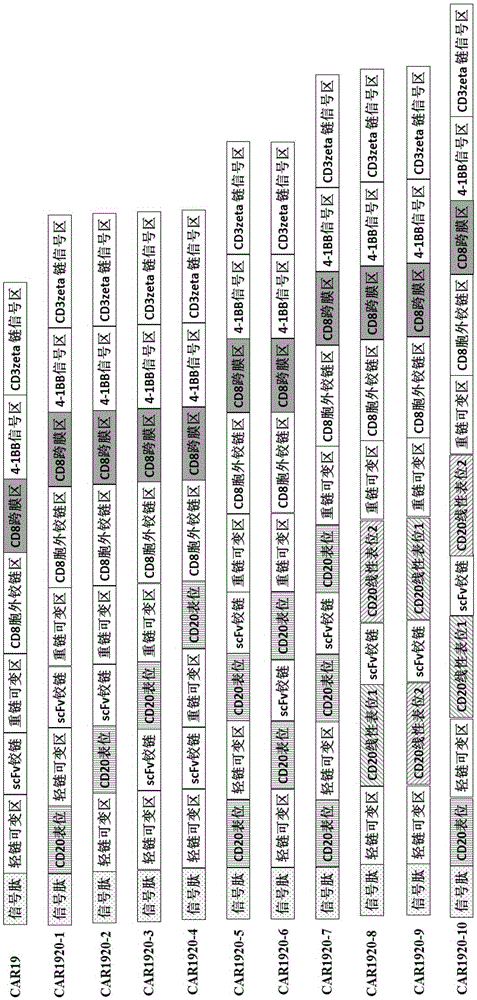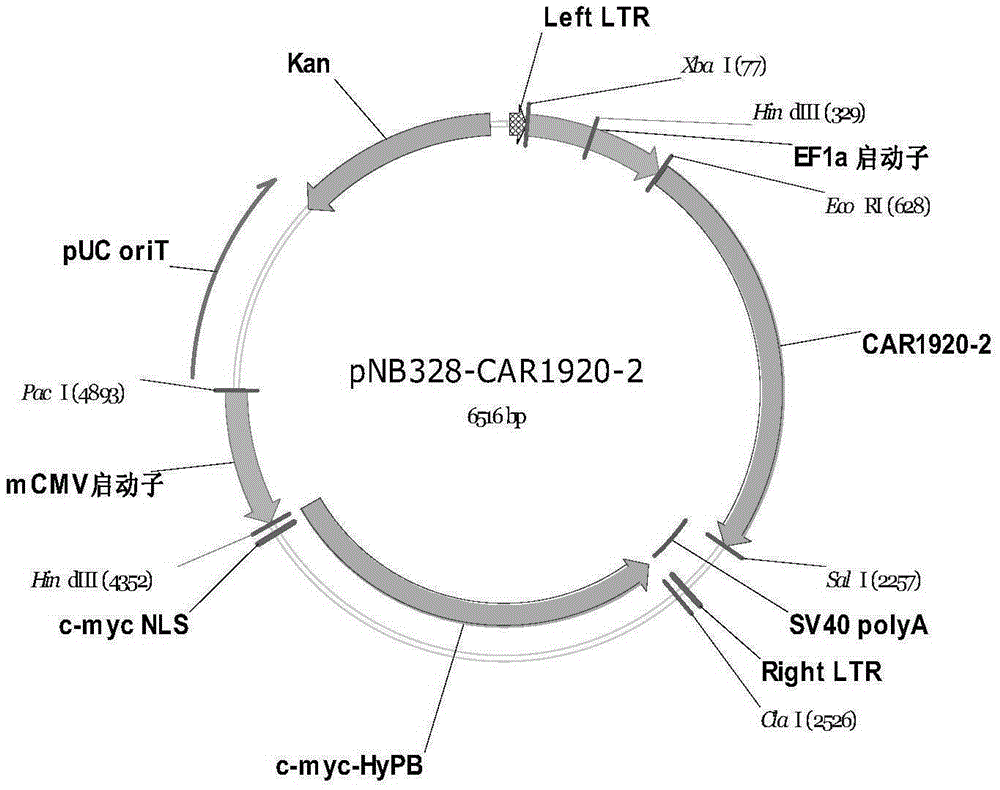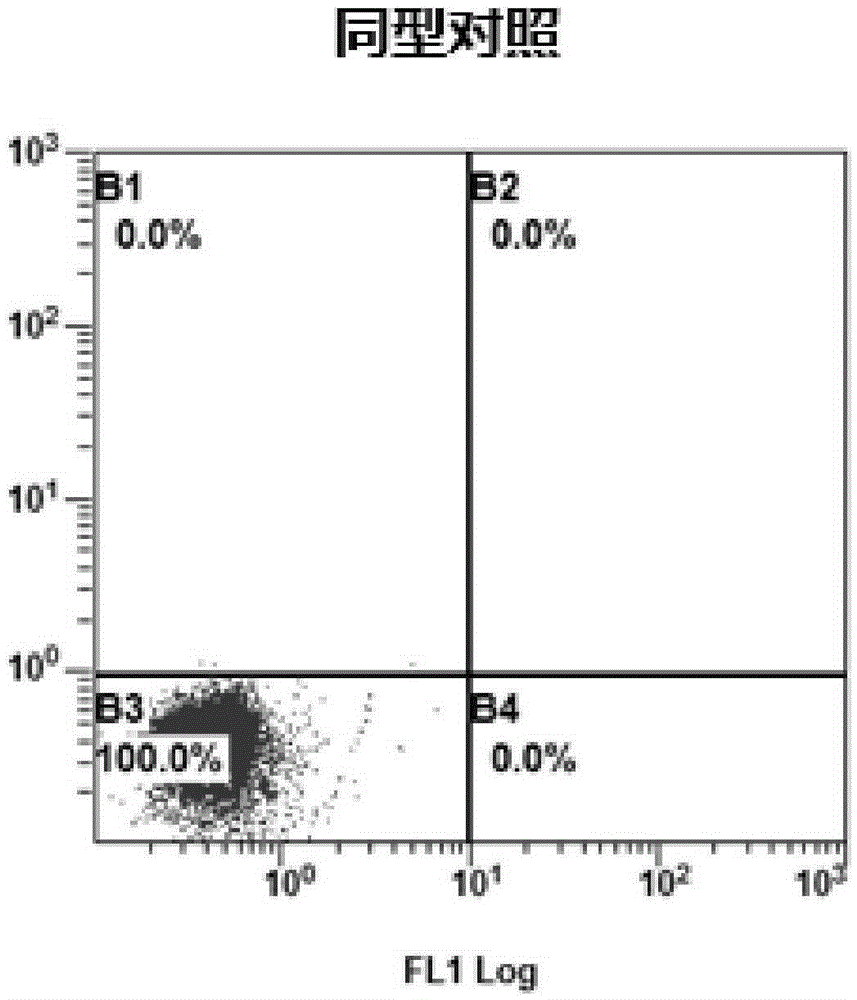Molecular brake for rapidly stopping killing effect of CAR-T (T cell engineered with chimeric antigen receptors) and application of molecular brake
A technique for cellular and intracellular signaling, used in the fields of immunology and cell biology
- Summary
- Abstract
- Description
- Claims
- Application Information
AI Technical Summary
Problems solved by technology
Method used
Image
Examples
Embodiment 1
[0082] Example 1: Design and expression of CD19-specific CAR containing CD20 molecular brake Vector construction
[0083] According to the different insertion positions of the CD20 molecular brake, 10 types of CD19-specific CARs were designed and constructed (see figure 1), were spliced into the entire fused amino acid sequence and the coding DNA expression frame, and were named CAR1920-1, CAR1920-2, CAR1920-3, CAR1920-4, CAR1920-5, CAR1920-6, CAR1920-7, CAR1920-8, CAR1920- 9. CAR1920-10. in:
[0084] The amino acid residue sequence of CAR1920-1 is: (546aa)
[0085] MALPVTALLLPLALLLHAARPS GG GGGGGGG DIQMTQTTSSLSASLGDRVTISCRASQDISKYLNWYQQKPDGTVKLLIYHTSRLHSGVPSRFSGSGSGTDYSLTISNLEQEDIATYFCQQGNTLPYTFGGGTKLEIT EVKLQESGPGLVAPSQSLSVTCTVSGVSLPDYGVSWIRQPPRKGLEWLGVIWGSETTYYNSALKSRLTIIKDNSKSQVFLKMNSLQTDDTAIYYCAKHYYYGGSYAMDYWGQGTSVTVSSAAAFVPVFLPAKPTTTPAPRPPTPAPTIASQPLSLRPEACRPAAGGAVHTRGLDFACDIYIWAPLAGTCGVLLLSLVITLYCNHRNRFSVVKRGRKKLLYIFKQPFMRPVQTTQEEDGCSCRFPEEEEGGCELRVKFSRS...
Embodiment 2
[0147] Example 2: Genetic modification of T cells
[0148] Prepare 1×10 7 Peripheral blood mononuclear cells (PBMC) obtained by fresh isolation, respectively, 6 μg of pNB328-CAR1920-1, pNB328-CAR1920-2, pNB328-CAR1920-3 prepared in Example 1, The pNB328-CAR1920-4 plasmid was transfected into the nucleus, and placed at 37°C, 5% CO 2 Culture in an incubator; transfer to a 6-well plate containing 30ng / mL anti-CD3 antibody and 3000IU / mL IL-2 (purchased from Novoprotein) after 6 hours, and place at 37°C, 5% CO 2 Incubator culture. After the cells were confluent, they were subcultured at a ratio of 1:5. After 3 passages, the proportion of CAR-positive cells was detected by flow cytometry (goat anti-mouse Fab2' antibody, purchased from Jackson, USA).
Embodiment 3
[0150] Example 3: In vitro brake function test of CAR19-T cells containing CD20 molecular brake Measurement
[0151] 1. Construction of HEK293 cells (target cells) stably expressing CD19 gene
[0152] 1) According to the DNA coding sequence of the extracellular region and transmembrane region of CD19, Shanghai Jereh Biotechnology Co., Ltd. was commissioned to synthesize the whole gene and insert it into the pNB328 vector. The constructed vector was named pNB328-CD19.
[0153] The coding sequence of CD19 extracellular region and transmembrane region is as follows: (960bp)
[0154] ATGCCACCTCCTCGCCTCCTCTTCTTCCTCCTCTTCCTCACCCCCATGGAAGTCAGGCCCGAGGAACCTCTAGTGGTGAAGGTGGAAGAGGGAGATAACGCTGTGCTGCAGTGCCTCAAGGGGACCTCAGATGGCCCCACTCAGCAGCTGACCTGGTCTCGGGAGTCCCCGCTTAAACCCTTCTTAAAACTCAGCCTGGGGCTGCCAGGCCTGGGAATCCACATGAGGCCCCTGGCCATCTGGCTTTTCATCTTCAACGTCTCTCAACAGATGGGGGGCTTCTACCTGTGCCAGCCGGGGCCCCCCTCTGAGAAGGCCTGGCAGCCTGGCTGGACAGTCAATGTGGAGGGCAGCGGGGAGCTGTTCCGGTGGAATGTTTCGGACCTAGGTGGCCTGGGCT...
PUM
 Login to View More
Login to View More Abstract
Description
Claims
Application Information
 Login to View More
Login to View More - R&D
- Intellectual Property
- Life Sciences
- Materials
- Tech Scout
- Unparalleled Data Quality
- Higher Quality Content
- 60% Fewer Hallucinations
Browse by: Latest US Patents, China's latest patents, Technical Efficacy Thesaurus, Application Domain, Technology Topic, Popular Technical Reports.
© 2025 PatSnap. All rights reserved.Legal|Privacy policy|Modern Slavery Act Transparency Statement|Sitemap|About US| Contact US: help@patsnap.com



